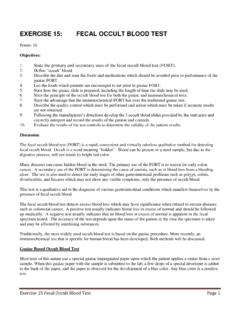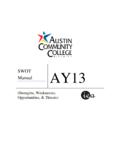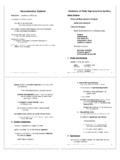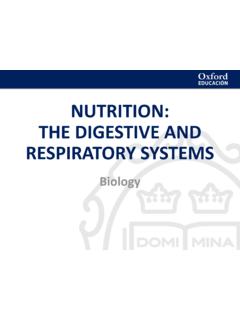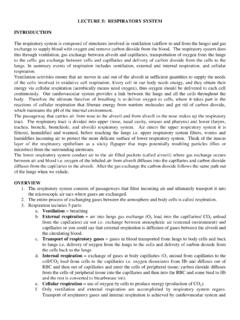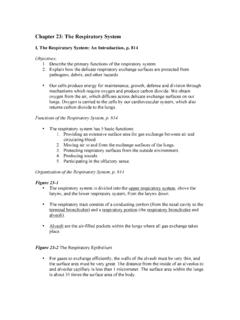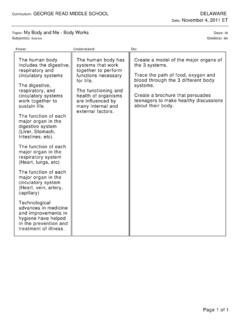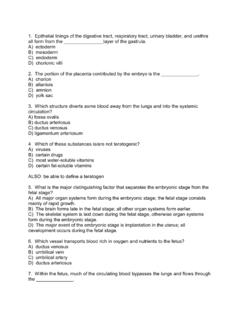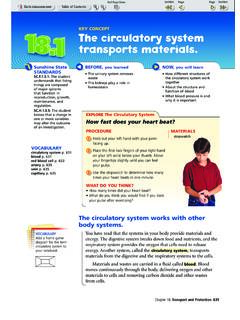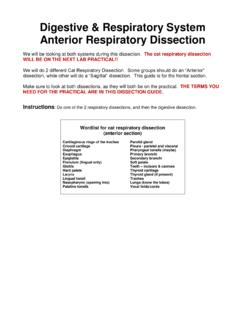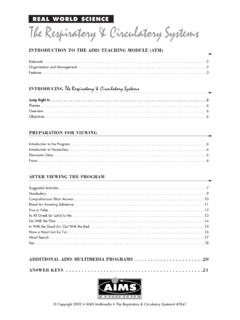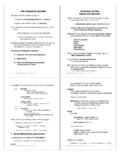Transcription of l.The Respiratory System 2404 - Austin Community College
1 Human Anatomy and Physiology: Respiratory System ; Ziser Lecture Notes, 1 The Respiratory System Respiratory System functions mainly as gas exchange System for O2 andCO2 ! cellular respiration (energy production) closely tied to circulatory System General Functions of Respiratory System : 1. O2 and CO2 exchange between blood and air 2. speech and vocalization 3. sense of smell 4. helps control acid base balance of body 5. breathing movements help promote blood and lymph flow Human Anatomy and Physiology: Respiratory System ; Ziser Lecture Notes, 2 Anatomy of the Respiratory System Main Organs: nose pharynx larynx trachea primary bronchi lungs: bronchioles alveoli/ Respiratory membrane these organs can also be subdivided into: upper Respiratory tract nose!pharynx!larynx lower Respiratory tract Respiratory organs of the thorax the lower Respiratory tract fills most of the Thorax (Thoracic Cavity) major portion is inside lungs air passageways must be held open at all times !
2 Nasal passageways and throat follow passages in skull bones and cartilage !others held open by rings of cartilage 1. Nose Human Anatomy and Physiology: Respiratory System ; Ziser Lecture Notes, 3 separated from mouth by hard and soft palate cleft palate bones don t unite completely produces difficulties in swallowing each nasal cavity is divided into 3 passageways by turbinates ! creates narrow, turbulent passageways to insure that all air makes contact with mucous membranes lined with ciliated mucous membranes containing goblet cells membranes are heavily vascualrized ! remove bacteria, debris and particles mucous blanket: produces 125 ml/day cilia move it 1-2 cm/min ! warms and moisturizes air entering lungs ! also contains receptors for smell nasolacrimal ducts drain into nasal cavity paranasal sinuses are accessory structures: sound resonance (other animals) warm and moisten air lighten skull 2.
3 Pharynx (throat) Human Anatomy and Physiology: Respiratory System ; Ziser Lecture Notes, 4 from base of skull to junction with esophagus and trachea 5 long made of muscle and lined with mucous membrane junction between digestive and Respiratory systems divided into three regions: a. Nasopharynx behind nose to level of soft palate includes uvula tonsils (adenoids) auditory tube (eustachian tube) drains here b. Oropharynx behind mouth from soft palate to level of hyoid bone palatine and lingual tonsils c. Laryngopharynx from hyoid bone to esophagus/larynx 3. Larynx (voice box) enlarged beginning portion of trachea composed of cartilage and muscles Human Anatomy and Physiology: Respiratory System ; Ziser Lecture Notes, 5 opening into larynx = glottis prevent food from entering lower Respiratory System sound ! speech, singing, etc 9 cartilages (3 large, 6 small): epiglottis covers glottis when swallowing in infants, the epiglottis is high in throat and touches the soft palate !
4 Allows infants to eat and breath at same time, epiglottis deflects foods away from glottis this advantage is lost by age 2 when root of tongue becomes more muscular forcing larynx lower thyroid cartilage largest cartilage of larynx testosterone stimulates the growth of the laryngeal prominence so it becomes larger in males than in females = adam s apple cricoid cartilage smaller cartilage below thyroid connects larynx to trachea two muscular folds within larynx: upper: (false) vocal cords (=vestibular folds) close glottis during swallowing Human Anatomy and Physiology: Respiratory System ; Ziser Lecture Notes, 6 lower: (true) vocal cords wall of larynx are very muscular ! some of these muscles help to control these two pairs of folds 4. Trachea extends from larynx to bronchi surrounded by C shaped bands of cartilage ends joined by bands of muscle tissue !
5 Holds walls open, prevents collapse lined by pseudostratified ciliated columnar epithelium tracheotomy 5. Bronchi trachea divides into two branches = bronchi which enter each lung bronchi resemble trachea in structure ! also supported by C-shaped cartilages also have lots of elastic connective tissue Human Anatomy and Physiology: Respiratory System ; Ziser Lecture Notes, 7 each bronchus enters lung and continues to divide into smaller and smaller branches = bronchi, then into microscopic bronchioles because of the extensive branching = bronchial tree 6. Lungs the remainder of the Respiratory System is contained within the two lungs left lung ! 2 lobes right lung ! 3 lobes all organs between the two lungs are located in the mediastinum mediastinum includes: heart heart is in its own sac = pericardium esophagus trachea major blood vessels attached to heart lungs are located in pleura cavity visceral pleura covers outer surface of lungs the pleurae and pleural fluid: Human Anatomy and Physiology: Respiratory System ; Ziser Lecture Notes, 8 1.
6 Help reduce friction act as a lubricant pleurisy=pleurae are dry and inflamed 2. create a pressure gradient as rib cage expands to draw air into the lungs 3. compartmentalization surround each lung and isolate it from other and pericardial sac prevent infections from spreading easily from one thoracic organ to another 7. Bronchioles smallest branches of Respiratory tree <1mm diameter no cartilage rings but larger branches may have small patches of cartilage lined with ciliated cuboidal epithelium and layer of smooth muscle asthma affects the smallest terminal bronchioles 8. Alveoli smallest bronchioles ( Respiratory bronchioles) have Human Anatomy and Physiology: Respiratory System ; Ziser Lecture Notes, 9 clusters of tiny sacs branching off = alveoli grapelike clusters 300-500 Million alveoli/lung single cell layer thick (squamous epithelium) enveloped by capillaries alveoli are the functional units of the Respiratory System actual site of gas exchange with blood alveoli increase in number and size until adolescence after adolescence, can increase in size only and if damaged, have only limited ability to repair themselves Human Anatomy and Physiology: Respiratory System ; Ziser Lecture Notes, 10 Physiology of Respiration Pulmonary Ventilation we move ~500 ml of air in and out of lungs with each breath involves moving air down a pressure gradient breathing involves 2 processes: inspiration expiration 1.
7 Inspiration an active contraction of diaphragm ! innervated by phrenic nerve may also involve contraction of the external intercostals contraction of diaphragm lowers pressure in thoracic cavity: outside pressure > pressure in lungs ! lungs inflate the work required for normal breathing is ~1-2% of body s total energy expenditure during heavy exercise that may increase to 15% of energy expended 2. Expiration normal expiration is mainly a passive process Human Anatomy and Physiology: Respiratory System ; Ziser Lecture Notes, 11 !relaxation of diaphragm volume of chest decreases, forcing air out of lungs may also involve contraction of internal intercostals & muscles of abdominal wall pressure in thoracic cavity is kept lower than pressure in outside air ! keeps lungs inflated pneumothorax opening in chest cavity eliminates pressure differential causes lungs to collapse Surface Tension also plays an important role in keeping the lungs inflated outer surface of lungs and inner surface of alveoli are covered with thin film of water water has a high surface tension (very sticky ) on outer surface of lungs: !
8 Visceral pleura tends to stick to parietal pleura creates slight negative pressure Human Anatomy and Physiology: Respiratory System ; Ziser Lecture Notes, 12 helps to inflate lungs during inspiration on inside of alveoli: ! tends to cause the alveoli to collapse upon themselves counteracted by: a. lungs never completely deflated; always contain some air b. secrete surfactant reduces surface tension in alveoli not produced until 8th month of pregnancy ! Respiratory distress syndrome Respiratory Volumes the volume of air exchanged in breathing is measured with a spirometer provides information on pulmonary functions eg. Tidal Volume (TV) normal volume of air with each breath small part of total lung capacity (~10%) ~500 ml Human Anatomy and Physiology: Respiratory System ; Ziser Lecture Notes, 13 eg. Vital Capacity (VC) largest volume of air that can be moved into or out of lungs vital capacity is affected by: a.
9 Overall size of individual, gender! size of lungs b. volume of blood in lungs ! eg congestive heart failure c. excess fluid in pleural or abdominal cavity d. loss of lung elasticity ! eg. emphysema e. misc health related factors ! eg. smoking, exercise, etc eg. Residual Volume air that cannot be removed from lungs ~1200 ml removed in pneumothorax Nonrespiratory Air Movements speech ! communication cough ! removes junk from lower resp passages, reflex sneeze ! clears upper resp. passages, reflex laughing crying ! emotional state hiccup ! spasmodic contraction of diaphragm yawn, sigh ! with shallow breathing, eventually surface tension can overcome surfactant and alveoli start to collapse; an occasional deep breath reinflates them ! forces lungs open again since chest muscles are stronger than surface tension Alveolar Gas Exchange Human Anatomy and Physiology: Respiratory System ; Ziser Lecture Notes, 14 the exchange of gasses in the lungs takes place between alveolar air and venous blood gas exchange occurs across the lining of the alveoli and capillaries (2 cell layers thick) !
10 Respiratory membrane total surface area ~ 70 (60-80)m2 (=760 ft2 ~20 x38 ; = tennis court) Gas exchange is the result of simple diffusion down oxygen and carbon dioxide concentration gradients: Alveoli Blood Entering Lungs PO2 105mmHg 40mmHg PCO2 39mmHg 46mmHg The exchange of gasses in tissues is also by simple diffusion: Blood leaving lungs Tissues PO2 104mmHg !40mmHg PCO2 40mmHg "45mmHg Human Anatomy and Physiology: Respiratory System ; Ziser Lecture Notes, 15 Transport of Gasses in Blood A. Oxygen almost all hemoglobin in blood going through lungs manages to pick up oxygen ! 98% saturation versus ~70% saturation in venous blood ! hemoglobin has a very high affinity for O2 only ~2% of O2 is carried dissolved in plasma Hyperventilation doesn t increase PO2 of blood only slightly increases dissolved O2 concentrations !


